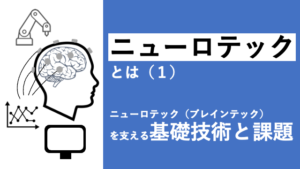What is Neurotech (Braintech) (2):
Neurotech areas of application
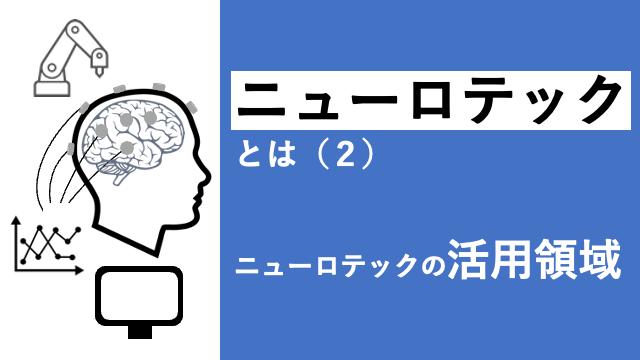
3. the state of neurotech in companies and countries
The current market size is estimated to be worth JPY 4 trillion (Mitsubishi Research Institute*3.1) and is expected to increase. In addition, there are more than 1,200 companies, mainly in the USA and Europe, and the total amount of investment in companies is expected to rise to USD 8 billion (approximately JPY 900 billion, Neurotech Investment Digest) by 2020, 21 times the amount invested in 2010. (*3.2)
(*3.1) Brain tech is opening up a ¥5 trillion global market Part 1: The current state of Brain Tech, creating new businesses through the application of neuroscience.
(*3.2) INVESTMENT DIGEST | Neurotech
This section will touch on recent developments in companies and on basic research in various countries.
3.1 Recent developments in the enterprise
A number of companies are currently involved in the neurotech business, mainly in the development of devices such as measurement and stimulation technologies. ARAYA has also entered the BMI business as a neurotech company [figure 6].
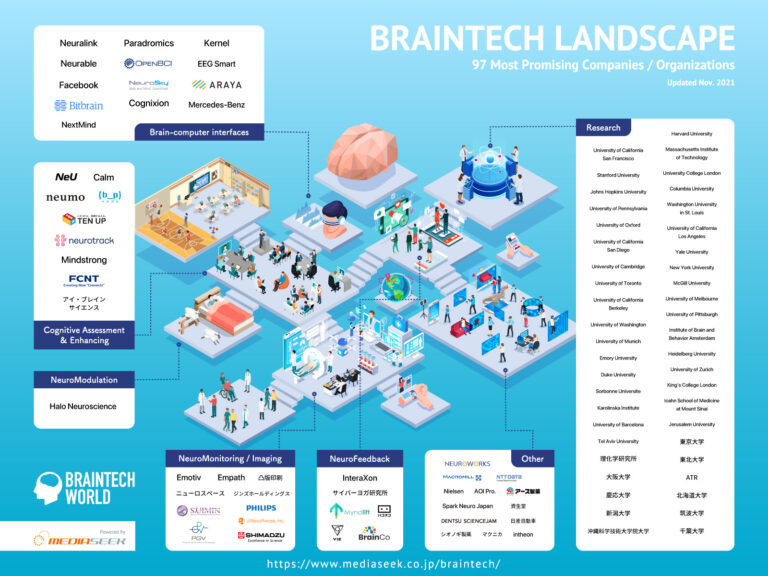
From 2019 onwards, big announcements from Neuralink (founded: 2016, CEO: Elon Musk) andKernel (founded: 2016, CEO: Brian Johnson), founded by successful entrepreneurs, attracted a lot of attention.
Neuralink is a neurotech company founded by Elon Musk, the head of Tesla electric cars, with $100 million of his own money in 2021, with news of an additional $200 million investment.
Wireless invasive miniature electrodes are being developed to operate smartphones. We are progressively developing devices to enable humans to communicate, such as those with physical paralysis.
In 2020, brain activity was successfully extracted from a walking pig; in 2021, a video was released showing a monkey playing a game using brain activity; in 2022, the company is well on its way to practical application, including the recruitment of a director to carry out clinical research using humans as subjects.
Kernel is a neurotech company founded by Brian Johnson, who made his fortune selling his online payments business. It has already received more than USD 100 million in investment, including his own.
In contrast to Neuralink, it focuses on developing non-invasive devices and achieving high performance.
The Kernel Flow, a NIRS-based device for measuring brain activity, has already been launched for the business sector (consumer version is planned for 2024).
Attention is now focused on how accurately brain activity can actually be extracted.
Others include Hinge Health (raised: $1bn, Series E), a developerofneurostimulation devices that has received significant investment in 2021 , andAxonics Modulation Technologies (raised: over $600m, IPO), which develops implantable brain stimulation devices More than 50% of the world's neurotech companies are located in the USA, which is now the centre of neurotech development.
Asia attracts around 6% of all companies.
Neural Galaxy (Beijing Yu Brain Galaxy Technology), which has attracted attention with an investment of more than USD 8 billion in 2021, aims to develop treatments for brain diseases.
It operates in Beijing and Boston and was co-founded by entrepreneur Coach Wei Kacheng, Professor Liu Hesheng of Harvard Medical School, Professor Robert Desmone of the Massachusetts Institute of Technology and others.
In addition, miHoYo (founded: 2012, CEO: Li Chengtian), provider of the hit mobile game Huan Shen (annual sales of more than 200 billion yen), has also started R&D for clinical applications with Ruijin Hospital, affiliated with Shanghai Jiao Tong University.
In other consumer markets.
- NextMind (CEO: Sid Kouider), a French company offering devices that use visual brain waves.
- emotiv (CEO: Tan Le), an Australian company offering headset-based EEG-type measuring devices.
- VIE STYLE (CEO: Yasuhiko Imamura), a Japanese developer of earphone-based EEG-type measuring devices.
New devices are being developed by companies around the world, including
3.2 Investment in basic research in different countries
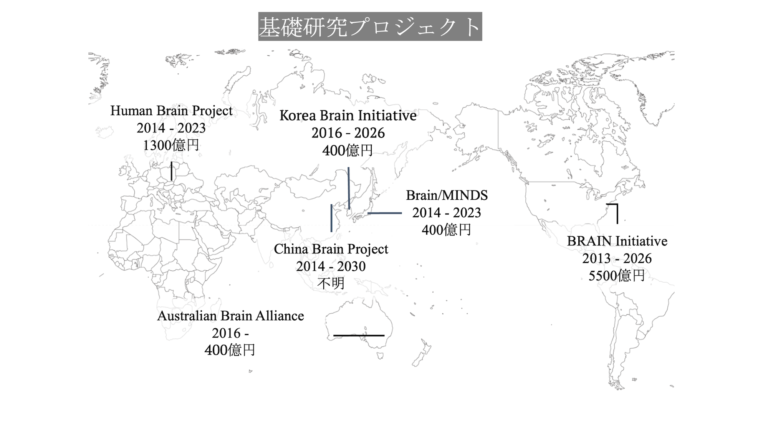
Several countries and regions, as well as companies, have been investing in basic research on neurotech since the early 2010s, and several large-scale projects have been developed.
In the USA, the BRAIN Initiative, led by the National Institutes of Health (NIH), is slated to receive more than â'¬550 billion in funding from 2014 to 2026 [Ngai, 2022]. In Europe, the Human Brain Project, led by the European Commission (EC), is expected to receive around â'¬130 billion over 10 years until 2023.
Several projects, including the Brain/MINDS[Okano et al., 2016] project supported by the Japan Agency for Medical Research and Development (AMED), and the Brain and Mind Research Promotion Programme are also operated in Japan. Other projects related to neurotech, such as 'Freeing the body from its constraints by extending physical and perceptual capabilities', are also partly promoted by the National Science and Technology Agency (JST) under its Moon Shot-type R&D programme (total budget: 115 billion yen planned).
In addition, neurotech initiatives have begun in Australia (The Australian Brain Alliance), South Korea (Korea Brain Initiative, 2016-2026) and China (China Brain Proejct, 2016-2030). The following is a list of the most common reasons for this.
In the future, the seeds generated from these neurotech projects will be the focus of attention.
4. ARAYA initiatives
ArayaIn addition to its own neurotech research and development, the company has also provided solutions/analysis support to businesses and collaborated extensively with related parties (e.g. as a supporting member of the Consortium for Applied Brain Science).
Arayaoffers the following major services.
- Brain sensing solutions
- Face2Brain - image-based EEG estimation solution - (*patent pending).
- Brain Performance Indicator - EEG-based performance estimation.
- BMI DEVELOPMENT SUPPORT
- Other brain data utilisation support
- Support for neuromarketing
- Brain data (e.g. fMRI) analysis support and consulting
4.1. brain sensing solutions
Arayaprovides solutions for sensing various brain states (e.g. drowsiness, concentration, etc.) using brain waves. Two main approaches are taken.
- Image-based, simpler sensing (Face2Brain).
In cases where it is difficult to wear an electroencephalograph at all times, such as use cases for car drivers, state estimation is carried out without the need for an electroencephalograph based on facial images, etc. in actual operation. - Brainwave-based, deeper sensing of information (Brain Performance Indicator).
Brain waves are analysed using our algorithms to estimate changes in brain states, such as momentary lapses in attention, with high resolution.
4.2. SUPPORT FOR BMI DEVELOPMENT
ArayaAt CEO, our company , Ryota Kanai has been appointed project manager for the Cabinet Office's moon shot-type research and development project "Freeing the body from constraints by extending physical and perceptual capabilities", which promotes research and development of BMI technology. This project promotes research into the realisation of the Internet of Brains (IoB), which communicates with others via the brain (https://brains.link/).
RESEARCH AND DEVELOPMENT OF SIMPLER EEG-BASED BMI IS ALSO BEING PROMOTED, WITH THE AIM OF SOCIAL IMPLEMENTATION.
4.3. Support for neuromarketing
Arayaprovides a service that supports efforts to understand brain activity during the product purchasing and usage process by analysing consumer brain data (EEG and fMRI) and utilising this information in marketing and product development.
4.4. support for analysis of brain data (e.g. fMRI)
Arayahas been providing services for businesses to support research and development on understanding human cognition using fMRI images.
We also analyse data from non-invasive devices such as fMRI and EEG measurements, as well as invasive device data such as invasive implanted electrodes and cortical electroencephalography (ECoG).
Currently, the data obtained from the brain is becoming vast and complex due to advances in devices, etc., and a vast amount of knowledge is required to prepare the appropriate analysis environment for each technology and to carry out analysis. Therefore, based on this knowledge, we have provided research institutions with an environment for automatic data analysis and analysis services using AI and machine learning technologies.
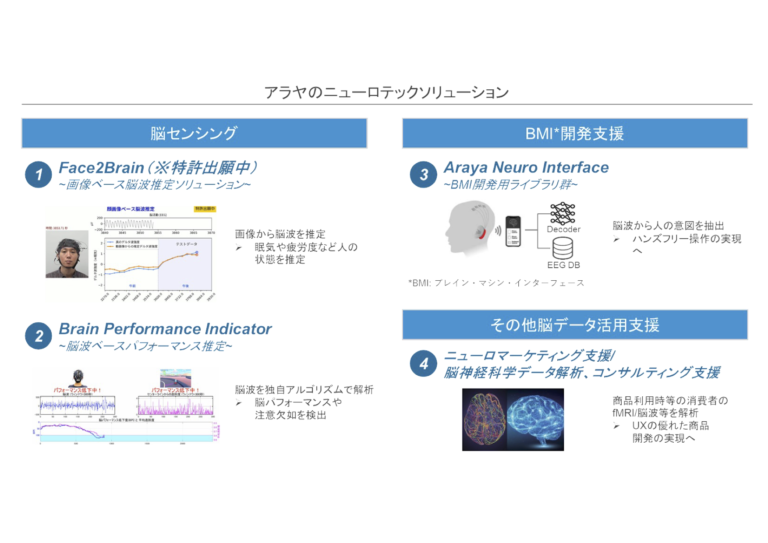
5. summary
In this article, we have shown the technology behind neurotech, the areas of use (use cases), representative companies and country-specific projects, and finally an overview of our approach/provided services.
As technology evolves, neurotech (BrainTech) is increasingly used and attracting attention in various fields, such as automotive, construction, healthcare and marketing.
If you are interested in the latest developments in neurotech, human brain sensing or BMI (Brain Machine Interface), please feel free to contact us at Araya.
(Authors: Taiyo Hamada, Satoshi Demoto, Shuntaro Sasai, Ayumi Kusano)

 Contact Us
Contact Us
